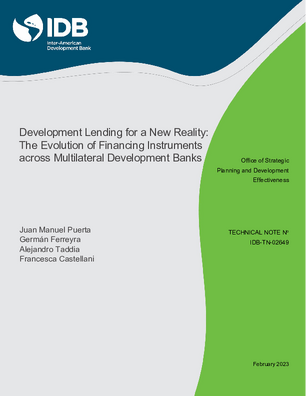Development Lending for a New Reality: The Evolution of Financing Instruments across Multilateral Development Banks
Date
Feb 2023
Multilateral development banks (MDBs) realize their objective of promoting sustainable development through a combination of financing (lending, guarantees) and non-financing instruments (technical assistance). This technical note reviews the historical evolution and existing offering of financing instruments across MDBs. Financing instruments can be roughly grouped into seven categories: traditional investment lending, programmatic approaches, policy-based lending, emergency lending, disaster risk management instruments, results-based lending, and guarantees. Financing instruments across all MDBs are remarkably similar and they were even introduced at about the same time. The existing offering of instruments is characterized by a high level of inertia, and thus remains dominated by the first lending instrument introduced at MDBs in the 1940s: the traditional Investment Loan.
In adapting to the new economic and social environment faced by borrowing member countries today, MDBs have the opportunity to rethink their lending toolkit. Investment lending could be simplified. The focus could be shifted from reviewing eligible expenses to ensuring the attainment of development results and the strengthening of national systems. Instruments that finance reforms as well as result-based instruments continue to have great potential for a renewed results focus. Finally, since the 1940s, MDBs have progressively moved from financing stand-alone infrastructure projects to financing all types of government programs over longer periods of time. Programmatic approaches that facilitate the preparation and assessment of development programs are likely to play an important role in the future.
In adapting to the new economic and social environment faced by borrowing member countries today, MDBs have the opportunity to rethink their lending toolkit. Investment lending could be simplified. The focus could be shifted from reviewing eligible expenses to ensuring the attainment of development results and the strengthening of national systems. Instruments that finance reforms as well as result-based instruments continue to have great potential for a renewed results focus. Finally, since the 1940s, MDBs have progressively moved from financing stand-alone infrastructure projects to financing all types of government programs over longer periods of time. Programmatic approaches that facilitate the preparation and assessment of development programs are likely to play an important role in the future.




